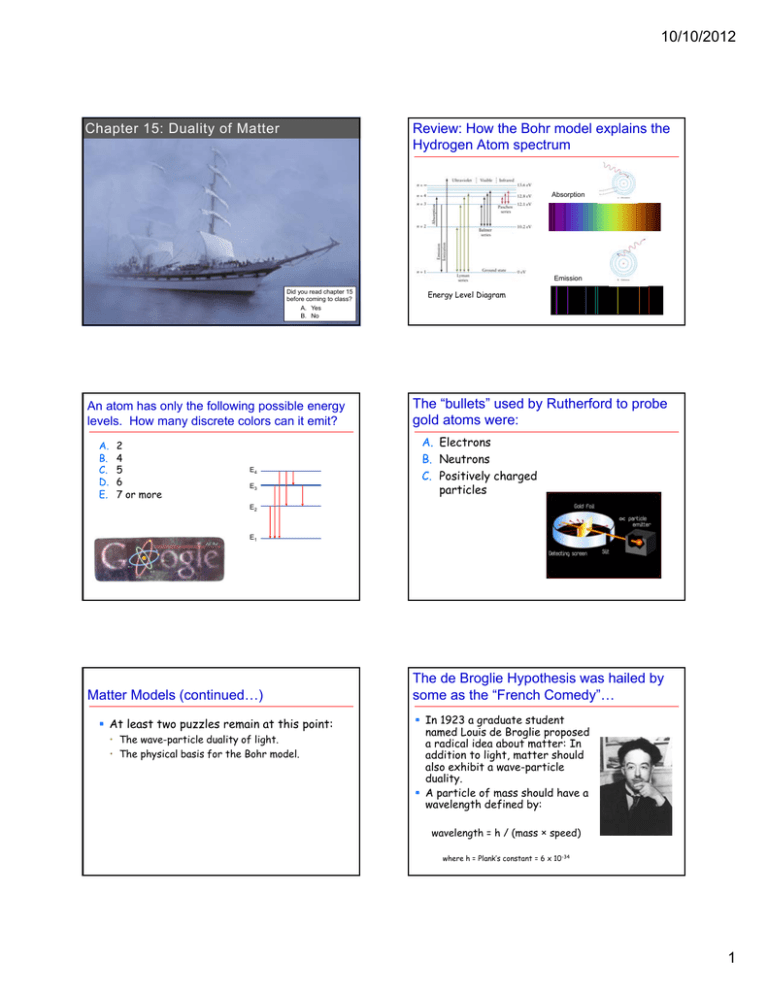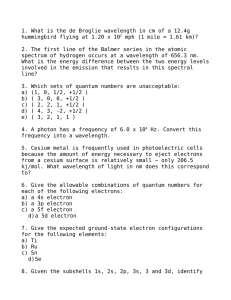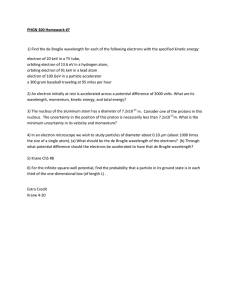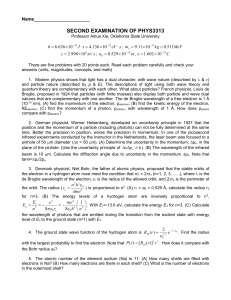10/10/2012
advertisement

10/10/2012 Review: How the Bohr model explains the Hydrogen Atom spectrum Chapter 15: Duality of Matter Absorption Emission Did you read chapter 15 before coming to class? A. Yes B. No An atom has only the following possible energy levels. How many discrete colors can it emit? A. B. C. D. E. 2 4 5 6 7 or more E4 E3 Energy Level Diagram The “bullets” used by Rutherford to probe gold atoms were: A. Electrons B. Neutrons C. Positively charged particles E2 E1 Matter Models (continued…) At least two puzzles remain at this point: • The wave-particle duality of light. • The physical basis for the Bohr model. The de Broglie Hypothesis was hailed by some as the “French Comedy”… In 1923 a graduate student named Louis de Broglie proposed a radical idea about matter: In addition to light, matter should also exhibit a wave-particle duality. A particle of mass should have a wavelength defined by: wavelength = h / (mass × speed) where h = Plank’s constant = 6 x 10-34 1 10/10/2012 But it turned out to describe what we observe. wavelength = h / (mass×speed) Examples De Broglie’s idea gave a reason for the Bohr orbits • where h = Plank’s constant = 6 x 10-34 Wavelength = 10-38 m (nonsense?) The quantized orbits of the Bohr model are predicted perfectly by requiring electrons to exactly wrap 1, 2, 3, etc waves around the nucleus. 60 mph Wavelength = 10-34 m (again nonsense?) 100 mph 2,000 mph Wavelength = 10-10 m Diameter of an atom… Nobel Prize, 1929 Why don’t we observe the wave nature of matter? To observe wave effects, your “slits” need to be similar to the wavelength wavelength = h / (mass×speed) h = 6 x 10-34 Example: It would take 1027 years for a student to “diffract” through a doorway. For all material objects except the very least massive (such as electrons and protons), the wavelength is so immeasurably small that it can be completely ignored. But are electrons really waves? Let’s see if they diffract. We need slits about the size of the electron wavelength (~10-10 m) to witness it. How do you make a slit that small? You can’t manufacture one, but nature provides something we can use: the space between atoms in a crystal. Fire an electron beam at a crystal and we DO get diffraction and interference patterns! Electrons ARE waves! Small electron wavelength is useful in electron microscopes Diffraction limits how small you can see with an optical microscope • When objects are about the size of the wavelength of light, light diffracts around the object so you can’t get a clear image. Electron wavelengths can be 1/1000th the size of optical wavelengths. So using electron beams we can “see” things 1000 times smaller with the same clarity. 2 10/10/2012 Review: The concept of a probability distribution For waves, we can use the amplitude as a measure of where the wave “is” Experimental double slit experiment using electrons So, which slit does the electron go through? Electrons are detected like particles, but the places that they are detected show interference patterns. This is essentially the same behavior we observed with photons! The results depend on how and what we measure. Don’t measure which hole the electron goes through wave-like interference. Do measure which hole the electron goes through particle-like behavior. How the electron behaves depends on whether it is observed. • Deep thought: How does one study an unobserved electron. Electron Detector So what is waving? The mass of the particle is not spread out and mechanically oscillating. The “wave” is interpreted as being the probability of locating the particle. • We have found the truth; and the truth makes no sense. (G. K. Chesterton) High amplitude corresponds to high probability of detection. It propagates like a pure wave with diffraction, interference, refraction, etc. Somehow electrons “know” about the existence of both slits even when we cannot prove that they ever go through more than one slit at a time. Clearly we need another model. 3 10/10/2012 Schodinger’s wave mechanics i The electron position is described with a probability wave When we measure the position, we find it at a certain position. We refer to this as the collapse of the wave function. ¶y ( r, t ) 2 2 = y (r, t ) + V (r, t ) y (r, t ) 2m ¶t The Uncertainty Principle and waves To find the trajectory of a particle we must know its position and velocity at the same time. How do you locate the position of a wave/particle electron? A well-defined momentum has a well-defined wavelength according to De Broglie. • wavelength = h / momentum Pure frequency wave unclear position but clear wavelength (momentum). Heisenberg Uncertainty Principle Electrons: fuzzy position and fuzzy wave properties. The uncertainty in position times the uncertainty in momentum (mass x velocity) is greater than Planck’s constant. Or Δx Δ(mv) > h Sharp pulse clear position but unclear wavelength (momentum). Consequences If we try to find out where an electron is, we know less about where it is going. • Measuring position more accurately makes uncertainty in momentum larger. • This is an alternative explanation for electron diffraction. 4 10/10/2012 So does the electron “know” where it is and where it is going? Philosophical shift in wave mechanics We could predict this interaction perfectly using Newton’s Laws of motion. 8 We cannot predict the results of this interaction perfectly in quantum mechanics. We can only give probabilities that certain outcomes will happen. ? ? Quantum mechanics experiments demonstrate that there is fundamental uncertainty in nature. It is not a matter of the experimentalist not being clever enough to measure both position and momentum at the same time. A particle simply does not have an exact position and an exact momentum at the same time. ? ? You are in good company if this bothers you a little… I remember discussions with Bohr which went through many hours till very late at night and ended almost in despair; and when at the end of the discussion I went alone for a walk in the neighboring park I repeated to myself again and again the question: Can nature possibly be as absurd as it seemed to us in these atomic experiments? ~Werner Heisenberg 5






